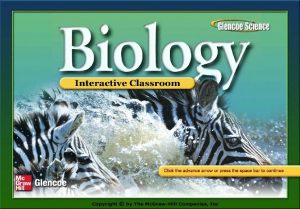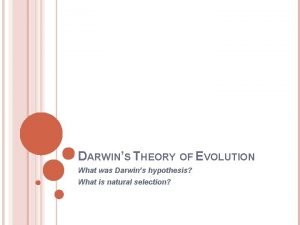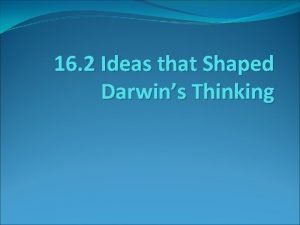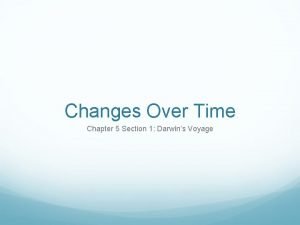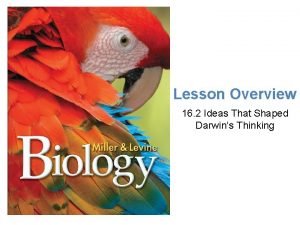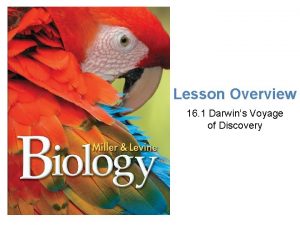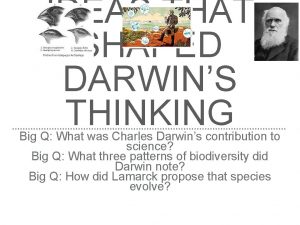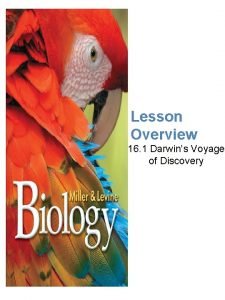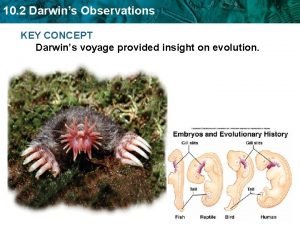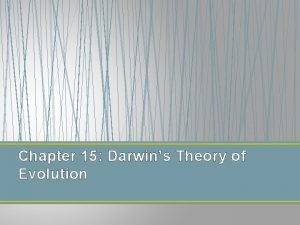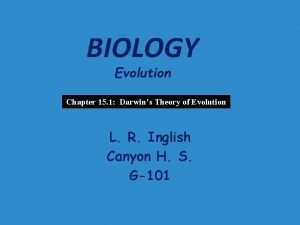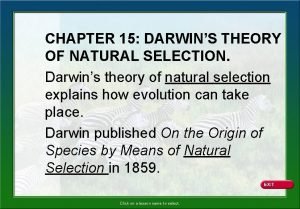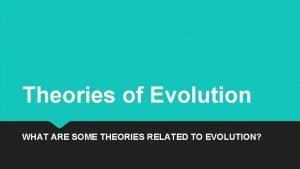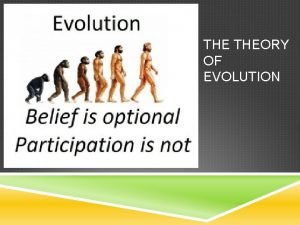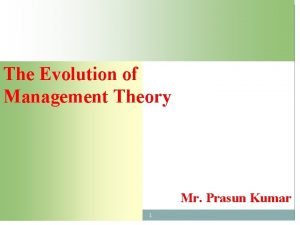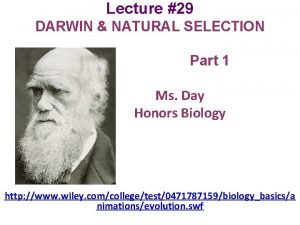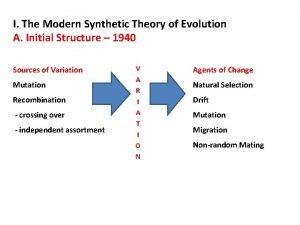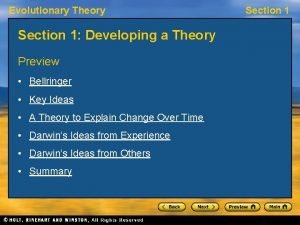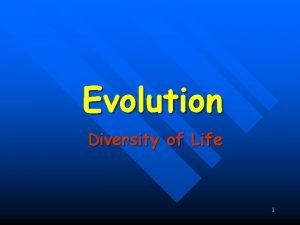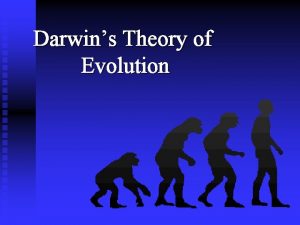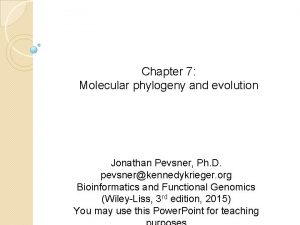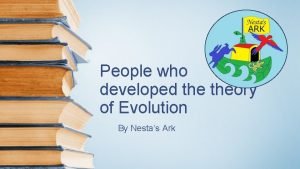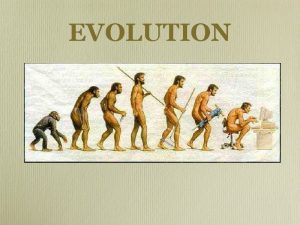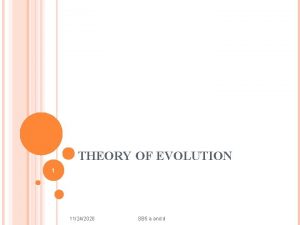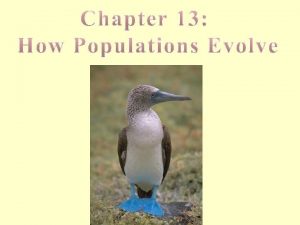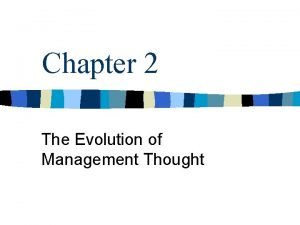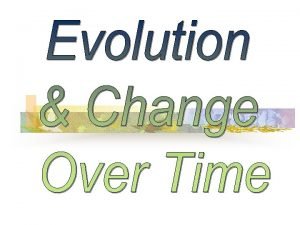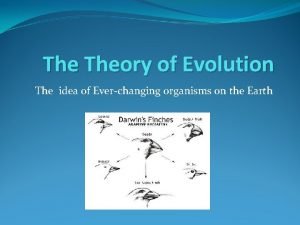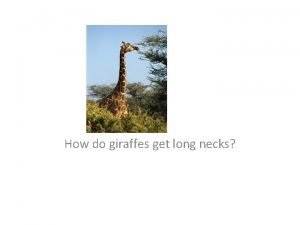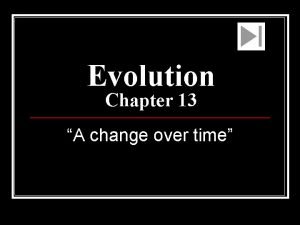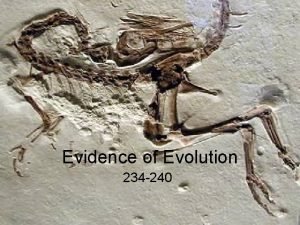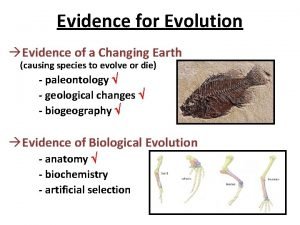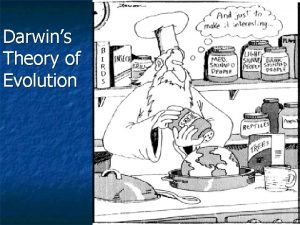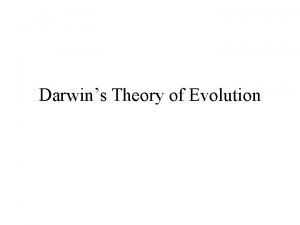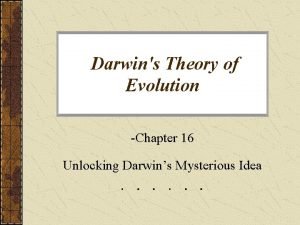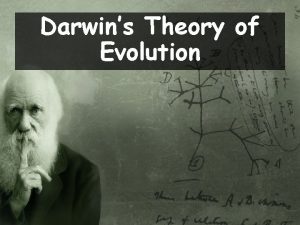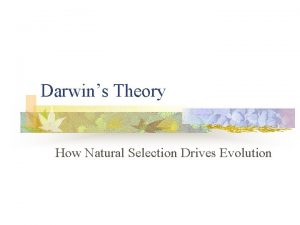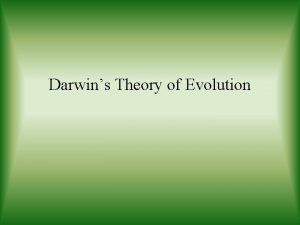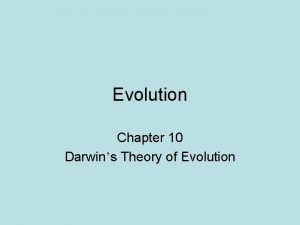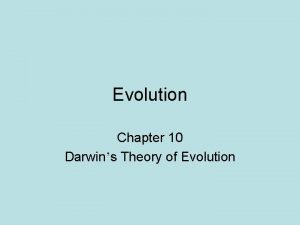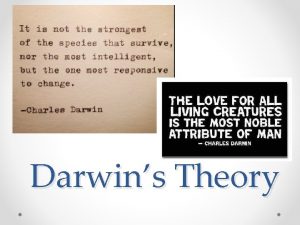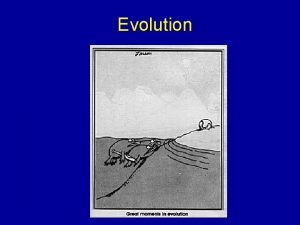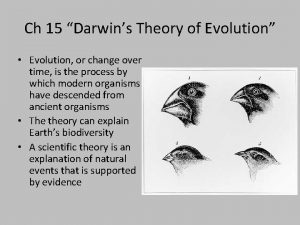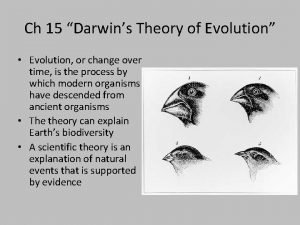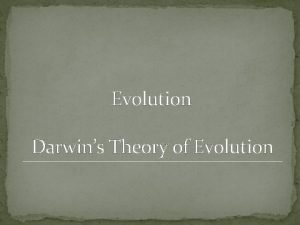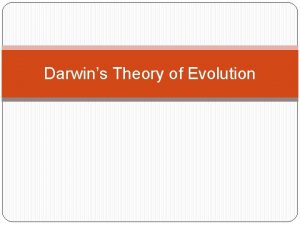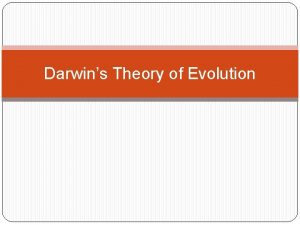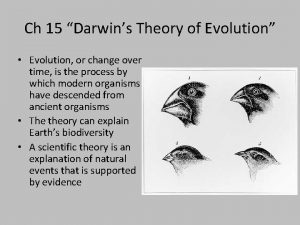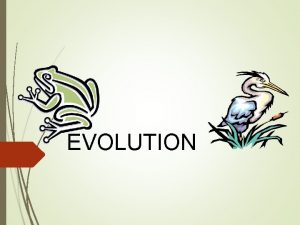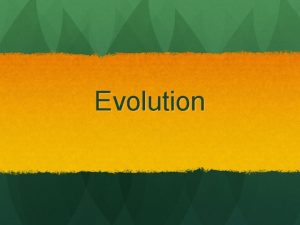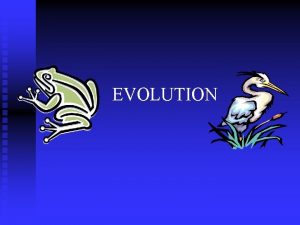Chapter 15 Darwins theory of Evolution I The


















































- Slides: 50


Chapter 15 -Darwin’s theory of Evolution I. The Puzzle of Life’s Diversity • • • __________-variety of organisms _________-change over time Voyage of the Beagle – Charles Darwinsailed__________(1831) and collected many scientific observations – particularly of interest at the area around S. America and the Galapagos Islands Biological Diversity H. M. S. Beagle



– Darwin collected ______ remains-some resembled living organisms and some did not--indicating species had disappeared . – Observed great diversity and saw so many organisms were well suited to their environments and various patterns ----leaving him w/ many questions… Fossilized

– Although the Galapagos Islands were very near S. America, their climates were different than S. America and each other. The _________ and iguanas varied in predictable ways from island to island/also many observations on variations in birds-eg. Size or shape of beak. – After returning to England , he began to wonder if the animals on different islands were once members of the same species. tortoises

II. Ideas that shaped Darwin’s thinking – – – Predominate thought was that the earth and inhabitants were only a couple thousand years old. _________ published a detailed hypothesis about the geological forces that have shaped the earthproposing layers of rocks formed slowly and the physical earth was shaped by a variety of forces. . ___________________ wrote Principles of Geology. ---stressed that scientists must explain past events based on processes they can actually observe---eg. By volcanoes that we still observe may we get an idea of how the earth has changed 1795 -James Hutton Charles Lyell in 1800’s

Lamarck – _________(1809)-realized organisms change over time but he felt that selective use or disuse of organs caused organisms to acquire or lose traits • 1) _______He said all organisms have a tendencies towards perfection. . thus continually acquiring characteristics to improve themselves----Thus he would say birds fly because they long ago tried to and their wings kept developing over the generations to fly. Perfection

USE AND DISUSE • • • INHERITANCE OF ACQUIRED CHARACTERISTICS 2) ________if something is used it is transformed for that purpose while if it not used, it would eventually disappear 3)__________. ---If a giraffe stretched its neck to reach its food, it would pass that trait on… 4)Evaluating Lamarck- incorrect in many ways– He did not know an organism’s experiences or behavior have no effect on inheritance



Thomas Malthus 1798 • Population Growth-_______-reasoned that if the human population continued to grow unchecked, sooner or later there would be insufficient space & food---war, famine and disease work against this • Darwin realized this applied less to humans than other animals and plants because ____________________ People do not reproduce as much young

III. Darwin presents his case • A. publication • 1858 -Alfred Russel Wallace summarized the thoughts on evolutionary change Darwin had been looking @ for 25 years…This gave Darwin the incentive to publish his work • 1859—Darwin Published “On the origin of Species…”proposed the mechanism for evolution to be ___________________ Natural selection

B. Inherited Variation and Artificial Selection • Members of each species vary from one another • Some variation heritable-passed on • ___________selective genetic variation where nature provides the variation and humans select to breed for this characteristic Artificial selection

C. Evolution by Natural Selection – 1) Struggle for existence • Applying Malthus’ principles, He realized high birth rate and shortage of resources produced ____________-struggle for existence---faster, etc. avoid being caught competition

2) Survival of the Fittest • • ___________=ability of an individual to survive and reproduce __________=any inherited characteristic that increases an organism’s chance of survival Organisms w/ low levels of fitness are unlikely to survive and reproduce _________________=survival of the fittest…. may inherited characteristics of a population Natural selection fitness adaptation

3) Descent with Modification • Over long periods , natural selection produces organisms that have different structures, establish different niches, or occupy different habitats---each species descends ___________. – Implies all living organisms are related to each other – _______________-all speciesliving and extinct were derived from common ancestors Modification/changes Common descent

D. Evidence of Evolution – – 1) Fossil Record-record of the history of life on earth-comparing fossils from different layers Felt the earth was millions of years old Since Darwin, people have discovered many transitional species in fossilized form Gaps remain—providing some uncertainty about how some species evolved

2)Geographic Distribution • With reference to birds he observed, Darwin felt although they varied, they descended with modification from common mainland S. American ancestor • Animals w/certain similarities between areas developed this way due to similar ecological conditions


3)Homologous Body Structures----structures that have different mature forms but develop from the same embryonic tissue • Example: The bones of a bird skeleton more closely resemble homologous bones of certain reptiles than that of bats


• ______________-traces of homologous organs…. appear to have no function Vestigial organs


4)Embryological Similarities-many embryos look esp. similar during certain stages of development…producing homologous structures

E. Summary of Darwin’s Theory Inherited traits • Individuals differ and some can be ______________. • Organisms produce more offspring that can survive and many do not _____________. • Organisms _______for limited resources. • Each unique organism has unique advantages and disadvantages in struggling for existence---Those best suited will reproduce, passing on their traits. • Species alive today descended with modification from ancestral species…uniting us in a single tree of life reproduce compete

Strengths and Weaknesses • Continues to change as new data and technology develop • Argument about extinction • Origin of life

Evolution cont’d-pieces of Chapter 16 & 17 • ___________=all genes, inc. all the different alleles, that are present in a population • ___________of an allele= # times that the allele occurs in a gene pool, compared with the # of times other alleles for the same gene occur. (often a %) • In genetic terms , evolution is any change in the relative frequency of alleles in a population. Gene pool Relative frequency

Sources of genetic Variation– 1)mutations – 2)gene shuffling – ----- Natural selection can affect the distribution of phenotypes in any of the 3 following ways: • 1) Directional selection-Individuals @ one end of curve have higher fitness than those @ middle or other end-Example-birds w/ large, wide beaks can crack large seeds…. If the supply of small seeds decreases, they dominate • 2) __________-individuals near center of curve have higher fitness—example-babies of average weight survive better than very low or high birth weights. Stabilizing Selection

• 3)_______________-individuals @ upper and lower end of curve have higher fitness than individuals near middle-example mid-sized seeds become less common and large beaked or small beaked birds both benefit. Disruptive selection


_________________= random change in allele frequency • Genetic Drift

______________Principle-allele frequencies in a population will be constant unless one or more factors change it. • 5 conditions for it(GENETIC EQUILIBRIUM) to hold – 1)genetic equilibrium from generation to generation – 2)random mating – 3)large pop. – 4)NO emigration or immigration – 5) no mutations or natural selection Hardy Weinberg

• __________= formation of new species • Due to • Isolation-reproductive isolation due to behavorial, geographic or ___________isolation(reproduce @ different times) speciation temporal


• _______________are scientists who study fossils Paleontologists

How fossils form: • sedimentary rock • sometimes an imprint and sometimes a preserved remains • buried in resin-amber • tar pits

Dating– compare w/other sediments and fossils – radioactive dating using half lives-esp. C-14, since its half life = 5730 years • Geologic Time scale-see p. 421


3 Eras Mesozoic • Paleozoic, ____________ and Cenozoic – 1) Paleozoic-diversity of marine life – 2) Mesozoic-increasing dominance of Dinosaurs, flowering plants appear – 3) Cenozoic-mammals evolved adaptations to allow them to live in various environments periods _________-are subdivisions of eras

• Earth’s early atmosphere probably contained Hcyanide, CO 2, CO, N, H 2 S and H 2 O • Miller & Urey’s experiments suggested how mixtures of the organic compounds necessary for life could have arisen from simpler compounds. This was not totally accurate –the experiment-but lead to similar experiments-even producing nitrogenous bases. • ~ 200 -300 million after earth cooled to carry water, cells similar to bacteria developed, beginning w/something similar to a cell membrane coacervate

Amino acids produced

• Next eukaryotic cells developed by_______________as a symbiosis formed between prokaryotes…. eventually specializing into organelles like_________ • Margulis supported this in the 1960’s w/the following evidence: – mitochondria and chloroplasts carry DNA similar to bacterial DNA. – mitochondria and chloroplasts have ribosomes similar to that of bacteria – mitochondria and chloroplasts reproduce by binary fission a lot like bacteria mitochondria Endosymbiotic Theory

Patterns of Evolution • 1)extinction • 2) ______________single species evolve into several different forms in different ways Adaptive radiation


3. ________________-unrelated organisms come to resemble one another • Convergent evolution

4. _______________-2 species evolve in response to changes in each other over time • Coevolution

• 5___________-long, stable periods, interrupted by brief periods of more rapid change In spurts • 6. _________--opposite of punctuated equil. ---slowly over a long period of time Punctuated equilibrium gradualism


 Chapter 17 darwins theory of evolution
Chapter 17 darwins theory of evolution Chapter 15 section 1 darwins theory of natural selection
Chapter 15 section 1 darwins theory of natural selection Darwin hypothesis
Darwin hypothesis Ideas that shaped darwin's thinking
Ideas that shaped darwin's thinking 15-2 ideas that shaped darwin's thinking
15-2 ideas that shaped darwin's thinking Section 2 darwins observations study guide a
Section 2 darwins observations study guide a Lesson 2: ideas that shaped darwin's thinking
Lesson 2: ideas that shaped darwin's thinking Species that vary locally
Species that vary locally Ideas that shaped darwins thinking
Ideas that shaped darwins thinking Lesson 1 a voyage of discovery
Lesson 1 a voyage of discovery Darwins observations
Darwins observations Chapter 15 darwin's theory of evolution
Chapter 15 darwin's theory of evolution Chapter 15 darwin's theory of evolution section 15-1
Chapter 15 darwin's theory of evolution section 15-1 Chapter 15 darwin's theory of evolution section review 15-1
Chapter 15 darwin's theory of evolution section review 15-1 Natural selection
Natural selection Lamarck's theory of evolution
Lamarck's theory of evolution What does the theory of evolution state
What does the theory of evolution state Evolution of management theory
Evolution of management theory Lamarck's theory
Lamarck's theory Synthetic theory
Synthetic theory Modern evolution theory
Modern evolution theory Lamarck’s theory of evolution.
Lamarck’s theory of evolution. Lamarck's theory of evolution
Lamarck's theory of evolution Neutral theory of molecular evolution notes
Neutral theory of molecular evolution notes Chapter 15 section 3 shaping evolutionary theory
Chapter 15 section 3 shaping evolutionary theory Charles darwin theory of evolution
Charles darwin theory of evolution Theory of natural selection
Theory of natural selection Lamarck theory of evolution notes
Lamarck theory of evolution notes Theory of evolution
Theory of evolution Theory of evolution
Theory of evolution Evolution of management thought
Evolution of management thought Examples of homologous structures
Examples of homologous structures Law of natural selection
Law of natural selection The image below shows phiomia an ancestor of elephants
The image below shows phiomia an ancestor of elephants Darwin's theory of evolution
Darwin's theory of evolution Theory of evolution
Theory of evolution The theory that evolution occurs slowly but steadily
The theory that evolution occurs slowly but steadily Lamarck theory of evolution
Lamarck theory of evolution The theory that evolution occurs slowly but steadily
The theory that evolution occurs slowly but steadily Hình ảnh bộ gõ cơ thể búng tay
Hình ảnh bộ gõ cơ thể búng tay Bổ thể
Bổ thể Tỉ lệ cơ thể trẻ em
Tỉ lệ cơ thể trẻ em Chó sói
Chó sói Tư thế worm breton
Tư thế worm breton Bài hát chúa yêu trần thế alleluia
Bài hát chúa yêu trần thế alleluia Môn thể thao bắt đầu bằng từ chạy
Môn thể thao bắt đầu bằng từ chạy Thế nào là hệ số cao nhất
Thế nào là hệ số cao nhất Các châu lục và đại dương trên thế giới
Các châu lục và đại dương trên thế giới Cong thức tính động năng
Cong thức tính động năng Trời xanh đây là của chúng ta thể thơ
Trời xanh đây là của chúng ta thể thơ

